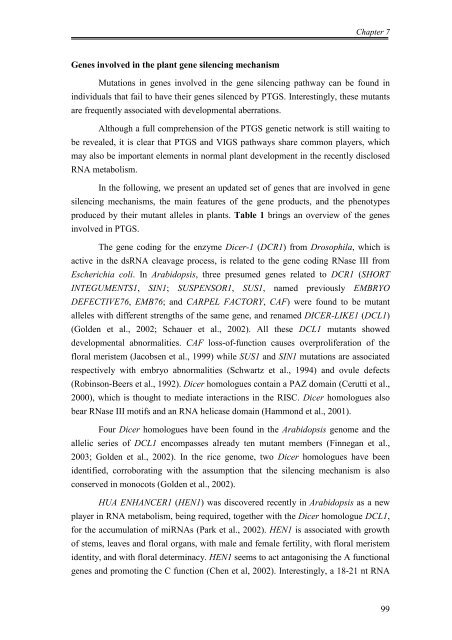Flower development of Lilium longiflorum - The Lilium information ...
Flower development of Lilium longiflorum - The Lilium information ...
Flower development of Lilium longiflorum - The Lilium information ...
Create successful ePaper yourself
Turn your PDF publications into a flip-book with our unique Google optimized e-Paper software.
Genes involved in the plant gene silencing mechanism<br />
Chapter 7<br />
Mutations in genes involved in the gene silencing pathway can be found in<br />
individuals that fail to have their genes silenced by PTGS. Interestingly, these mutants<br />
are frequently associated with <strong>development</strong>al aberrations.<br />
Although a full comprehension <strong>of</strong> the PTGS genetic network is still waiting to<br />
be revealed, it is clear that PTGS and VIGS pathways share common players, which<br />
may also be important elements in normal plant <strong>development</strong> in the recently disclosed<br />
RNA metabolism.<br />
In the following, we present an updated set <strong>of</strong> genes that are involved in gene<br />
silencing mechanisms, the main features <strong>of</strong> the gene products, and the phenotypes<br />
produced by their mutant alleles in plants. Table 1 brings an overview <strong>of</strong> the genes<br />
involved in PTGS.<br />
<strong>The</strong> gene coding for the enzyme Dicer-1 (DCR1) from Drosophila, which is<br />
active in the dsRNA cleavage process, is related to the gene coding RNase III from<br />
Escherichia coli. In Arabidopsis, three presumed genes related to DCR1 (SHORT<br />
INTEGUMENTS1, SIN1; SUSPENSOR1, SUS1, named previously EMBRYO<br />
DEFECTIVE76, EMB76; and CARPEL FACTORY, CAF) were found to be mutant<br />
alleles with different strengths <strong>of</strong> the same gene, and renamed DICER-LIKE1 (DCL1)<br />
(Golden et al., 2002; Schauer et al., 2002). All these DCL1 mutants showed<br />
<strong>development</strong>al abnormalities. CAF loss-<strong>of</strong>-function causes overproliferation <strong>of</strong> the<br />
floral meristem (Jacobsen et al., 1999) while SUS1 and SIN1 mutations are associated<br />
respectively with embryo abnormalities (Schwartz et al., 1994) and ovule defects<br />
(Robinson-Beers et al., 1992). Dicer homologues contain a PAZ domain (Cerutti et al.,<br />
2000), which is thought to mediate interactions in the RISC. Dicer homologues also<br />
bear RNase III motifs and an RNA helicase domain (Hammond et al., 2001).<br />
Four Dicer homologues have been found in the Arabidopsis genome and the<br />
allelic series <strong>of</strong> DCL1 encompasses already ten mutant members (Finnegan et al.,<br />
2003; Golden et al., 2002). In the rice genome, two Dicer homologues have been<br />
identified, corroborating with the assumption that the silencing mechanism is also<br />
conserved in monocots (Golden et al., 2002).<br />
HUA ENHANCER1 (HEN1) was discovered recently in Arabidopsis as a new<br />
player in RNA metabolism, being required, together with the Dicer homologue DCL1,<br />
for the accumulation <strong>of</strong> miRNAs (Park et al., 2002). HEN1 is associated with growth<br />
<strong>of</strong> stems, leaves and floral organs, with male and female fertility, with floral meristem<br />
identity, and with floral determinacy. HEN1 seems to act antagonising the A functional<br />
genes and promoting the C function (Chen et al, 2002). Interestingly, a 18-21 nt RNA<br />
99














